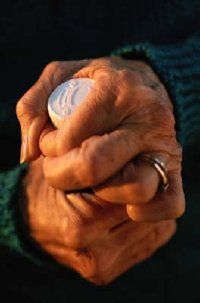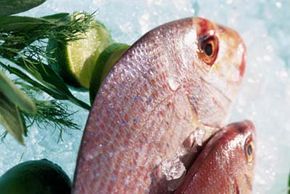Kitchen-crafted remedies can help ease the pain of arthritis. Read on to learn the benefits of everyday items like Epsom salts, aspartame, and dairy products.
Home Remedies From the Sink
There are no hard and fast rules when it comes to deciding whether heat, cold, or a combination of the two, will give you the best results. Experiment with hot and cold compresses to see what helps you most.
Hot compresses. Heat relieves pain primarily by relaxing muscles and joints and decreasing stiffness. In some instances, however, heat may aggravate a joint that's already "hot" from inflammation, as is sometimes the case with rheumatoid arthritis. On the other hand, osteoarthritis causes minimal inflammation and may respond well to heat application. You can make a heat compress with a hot, moist towel. If you find that your hot compress cools down quickly, you may want to try methods that offer more consistent heating. An electric blanket or heating pad can provide sustained dry heat. A warm shower, bath, or whirlpool can keep the wet heat coming. You can also purchase, at many drugstores and variety stores, a product consisting of a sealed, soft cloth pouch (often cylindrical in shape) filled with a natural grain that, when heated in the microwave and placed on the sore area, supplies more portable moist heat (one such product is named Bed Buddy). Using some method of warmth to loosen up the muscles before exercise can help them perform better.
Cold compresses. Cold puts the chill on joints that are "hot" from inflammation. Cold is ordinarily used to reduce pain in specific joints and can be helpful if you have gout. Cold application should not be used if you have vasculitis (inflammation of the blood vessels) or Raynaud's Phenomenon (a condition, characterized by spasms of the arteries in the fingers and toes, that may occur in conjunction with rheumatoid arthritis) without a doctor's approval, however. There are many ways to make a cold compress. You can run cold water in the sink and soak a washcloth in it. Or, you can use a plastic bag filled with crushed ice, a package of frozen peas, or a pack of blue ice, for example. Apply the cold compress to only one or two joints at a time, so you don't get a chill, and be sure to keep a thin cloth or towel between the ice pack and the skin to prevent frostbite.
You may find that alternating heat and cold gives you the most relief. For the best results, the Arthritis Foundation recommends the contrast bath: Soak your hands and feet in warm water (no more than 110 degrees Fahrenheit) for about three minutes, then soak them in cold water (about 65 degrees Fahrenheit) for about a minute. Repeat this process three times, and finish with a warm-water soak.
Home Remedies From the Cupboard
Aspartame. Drink your way to pain relief with a sugar-free soda pop. A research experiment published in the scientific journal Clinical Pharmacology and Therapeutics noted that aspartame--an artificial sweetener found in the brands Equal and NutraSweet--provides relief that's comparable to anti-inflammatory agents. Ask your doctor about the study and exactly how much you should drink.
Epsom salts. Magnesium sulfate, otherwise known as Epsom salts, is commonly used as a soak to relieve aching joints and reduce swelling. Mix a few heaping teaspoons into bath water and soak. More localized soaks are sometimes necessary, especially for the feet. Rest painful feet in a tub of warm water combined with 2 tablespoons Epsom salts.
Dairy products. Some medicines used to treat arthritis can lead to a loss of calcium from the bones, resulting in osteoporosis. To counteract this effect (and to keep healthy in general) make sure you get enough calcium in your diet. A cup of low-fat yogurt, for instance, supplies 300 to 400 mg calcium--about one-third of the adult daily requirement. Calcium-fortified orange juice will also help you meet your daily calcium needs.
Note: GLA is a blood thinner, so if you take NSAIDs (such as aspirin or ibuprofen), anticoagulant medications, or blood-thinning supplements, you increase your risk of uncontrolled bleeding.
Calcium. The Recommended Daily Allowance is 1,000 mg calcium per day for women prior to menopause and 1,200 to 1,500 mg after menopause. Men require 1,000 to 1,300 mg per day. If you don't get enough calcium in your diet, be sure to supplement to protect your bones.
Natural home remedies don't only come from the spice rack or stovetop. Little adjustments in the kitchen environment may make a big difference in protecting arthritic joints from injury or excessive strain.
- Buy kitchen drawer pulls with long, thin handles. These require a looser, less stressful grip.
- More padding means less pain. On tools that require a grip, such as brooms and mops, tape a layer of thin foam rubber around the handles and fasten with tape.
- Use lightweight pots and pans with comfortable handles.
- Pick up objects on the floor with a pair of long-handled pinchers (or a gripper).
- Transport groceries or heavy items from car to kitchen using a wagon or cart.
- Use loops made of soft but strong fabric or rope to pull the refrigerator and oven doors open without strain.
Arthritis is a common condition that cannot be cured, but fortunately its symptoms can be alleviated by the 40 home remedies outlined in this article. Try these home remedies and see which help your condition. And remember, see your doctor if you can't find relief.
For more information about arthritis and how to cope with its symptoms, try the following links:
- To see all of our home remedies and the conditions they treat go to our main Home Remedies page.
- Arthritis can be a potentially debilitating disease, significantly limiting the patient's ability to move. Herbs have been used to treat the pain and swelling of arthritis for centuries. Find out how in Herbal Remedies for Arthritis.
- To learn how to live a full and happy life despite your arthritis, read How to Adjust to Life With Arthritis.
- For tips on warding off joint discomfort, read How to Prevent Arthritis Pain.
ABOUT THE AUTHORS:
Timothy Gower is a freelance writer and editor whose work has appeared in many publications, including Reader's Digest, Prevention, Men's Health, Better Homes and Gardens, The New York Times, and The Los Angeles Times. The author of four books, Gower is also a contributing editor for Health magazine.
Alice Lesch Kelly is a health writer based in Boston. Her work has been published in magazines such as Shape, Fit Pregnancy, Woman's Day, Reader's Digest, Eating Well, and Health. She is the co-author of three books on women's health.
Linnea Lundgren has more than 12 years experience researching, writing, and editing for newspapers and magazines. She is the author of four books, including Living Well With Allergies.
Michele Price Mann is a freelance writer who has written for such publications as Weight Watchers and Southern Living magazines. Formerly assistant health and fitness editor at Cooking Light magazine, her professional passion is learning and writing about health.
ABOUT THE CONSULTANTS:
Ivan Oransky, M.D., is the deputy editor of The Scientist. He is author or co-author of four books, including The Common Symptom Answer Guide, and has written for publications including the Boston Globe, The Lancet, and USA Today. He holds appointments as a clinical assistant professor of medicine and as adjunct professor of journalism at New York University.
David J. Hufford, Ph.D., is university professor and chair of the Medical Humanities Department at Pennsylvania State University's College of Medicine. He also is a professor in the departments of Neural and Behavioral Sciences and Family and Community Medicine. Dr. Hufford serves on the editorial boards of several journals, including Alternative Therapies in Health & Medicine and Explore.
This information is solely for informational purposes. IT IS NOT INTENDED TO PROVIDE MEDICAL ADVICE. Neither the Editors of Consumer Guide (R), Publications International, Ltd., the author nor publisher take responsibility for any possible consequences from any treatment, procedure, exercise, dietary modification, action or application of medication which results from reading or following the information contained in this information. The publication of this information does not constitute the practice of medicine, and this information does not replace the advice of your physician or other health care provider. Before undertaking any course of treatment, the reader must seek the advice of their physician or other health care provider.



